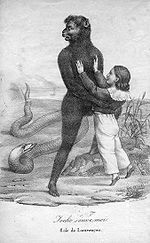| This article relies largely or entirely on a single source. Relevant discussion may be found on the talk page. Please help improve this article by introducing citations to additional sources. Find sources: "Jocko ou le Singe du Brésil" – news · newspapers · books · scholar · JSTOR (July 2011) |

Jocko ou le Singe du Brésil (Jocko or the Monkey of Brazil) is a two-act play by Edmond Rochefort, inspired by a novel of Charles de Pougens (1824).
Plot
A rich Portuguese man travelling to Brazil captures a monkey which, during the Atlantic crossing, saves the man's child from shipwreck and dies in doing so. In the second production the public demanded that the monkey survive.
Ballet
The play gave rise to a ballet by Frédéric-Auguste Blache, with music by Alexandre Piccinni and sets by Pierre-Luc-Charles Cicéri. The ballet was first put on at the Théâtre de la Porte Saint-Martin on Wednesday, 16 March 1825. Its main interpreters were Charles-François Mazurier [fr] and Louise Pierson.
The success of the ballet, a true bridge between the Enlightenment and Romanticism, was so great that many theatres in Paris and the French provinces put on the original version or competing works inspired by the same theme. There were over 160 productions in a single year. The Duchesse de Berry assisted in the first production in person, and the success was such that many things, such as dresses, fans, hairstyles and even a type of bread were nicknamed "jocko." It was revived three times that year and had many imitators. Jules Perrot, also in 1825, put on his version at the Théâtre de la Gaîté, entitled Sapajou.
The following year, Jean-Antoine Petipa put on his version at the Théâtre de la Monnaie, with Laurençon in the lead rôle; Filippo Taglioni reprised the theme at Stuttgart in Lanina ou le Singe brésilien and Antoine Titus [fr] put it on in Berlin.
Jocko ou le singe du Brésil saw a long success, even being put on the municipal theatre in Tunis at the end of the century. It was one of the precursors for the 20th-century fashion for tales of humanised monkeys like King Kong and Planet of the Apes.
References
- La Dépêche tunisienne, 4 February 1899